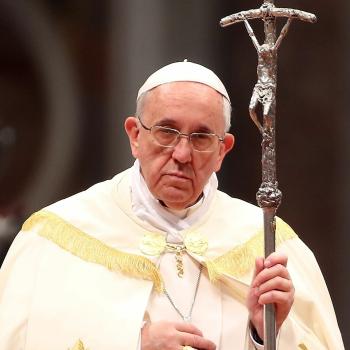When discussing Christian doctrine, Cardinal Newman made it quite clear, we cannot set different teachings of the faith against one another; rather, we must understand how they relate to each other and form from them one holistic truth. To do otherwise leads to error, and that error, if held firmly to against the pleas of the Church to reconsider, leads to heresy. “We must have a whole doctrine stated by a whole Church. The Catholic Truth in question is made up of a number of separate propositions, each of which, if maintained to the exclusion of the rest, is a heresy.”[1] This might seem strange to some people: if I hold a particular proposition to be true, and the Church teaches it, how can it be a heresy? The point is not that it is a heresy, but that it becomes a heresy if it is used to reject and ignore what the Church sees as being related to it. Thus one can believe Jesus was born of the Virgin Mary, but if you use that to say he is not God because God cannot be born, you have entered into heresy. While many who have studied theology have come across this understanding of heresy and have seen its applicability in areas such as Christology, Eschatology, or Ecclesiology, it seems to be rare for people to consider how true it is when dealing with Social Doctrine.
In the area of Catholic Social Doctrine, there is a tendency for Catholics to focus on a favored proposition (or two) while ignoring the rest. They explain political activity only under the auspices of that proposition, and thus ratify those political parties or traditions which seem to be tied to it and it alone (suggesting this is how we determine which political affiliations a “true believer” can have). Because they ignore the fullness of Catholic Social Teaching (CST), they don’t really understand the proposition they claim to hold to; to truly appreciate any specific doctrine, it must be seen in the light of the rest, and not entirely on its own. For those who know the authentic teaching of the Church, any one-sided approach ends up appearing unconvincing. Sadly, most people are not too familiar with CST, and they are capable of being led astray by ideologues who, knowing one or two elements of CST, trumpet those aspects, making it appear that their ideology as a whole is acceptable because of how it connects to those aspects of CST. In this fashion, CST is quickly turned upside down and used for the sake of partisan politics. Catholics should be careful when they hear CST used to justify adherence to one party and one party alone, because it is likely only a part of CST and not its fullness is being used to make such a suggestion.[2]
We cannot expect successful political parties, made up of people of different backgrounds and beliefs, to represent all the interests of CST. Political associations expect compromise by its affiliates. But this does not mean one has to accept the results of such compromise. Christians can never be satisfied with such a political approach to society. They must be pragmatic, to be sure, and through their prudential judgments, figure out what is possible in a given time and place, and work to make sure it happens, and this includes working with political associates who may or may not share all that a Christian looks for in society. Nonetheless, they must also work to change society by changing the hearts and minds of the people, and not just through politics.[3] Because political activity is but one means by which Christians are to engage the secular world, Christians need to consider what other means and methods they have at their disposal to bring change to society, and see if those other means might not, in the end, be more capable of producing a better society than political or legal means.
For this reason, people who focus, say, on subsidiarity alone and look at political parties in relation to how it follows their understanding of subsidiarity tend to do more harm than good to society as a whole. Subsidiarity is only one aspect of CST, and, as has been said above, when separated from the rest of CST, it can quickly lead to erroneous political and moral ideologies. Subsidiarity teaches us that social action should be taken on the lowest level of social interaction necessary to obtain a proper end. It does not, however, define what that proper end is. Taken to the exclusion of all other aspects of CST, subsidiarity would logically lead us to pure individualism. Every individual would claim their own ability to make decisions for themselves and demand the freedom to follow them out without interference from others, declaring any other level of social interaction unnecessary. We can see how the application of this, without any other teaching beside it, would allow for abortion. Subsidiarity by itself says the lowest unit of society possible, which would be the individual, should be allowed to make the decision for themselves; since there is nothing to balance this out to show why any decision cannot be made purely on the individual level, the answer then will say – the individual has the right to make that decision for themselves unhindered by society. So what if an individual kills someone else; to reflect upon the impact of a group of people (more than one individual) is to move beyond the lowest possible unit of decision, and into other categories of social thought, and would therefore be outside the dictates of pure subsidiarity. The child in the womb is also free to make decisions, but if it doesn’t decide to move out of the womb before it is killed, it is its own fault. Since there is nothing to balance out subsidiarity, the individual will always have the right to decide as they see fit; there could never be any higher authority to tell them not to act in such a way, because such an authority would suggest the individual cannot make decisions for themselves. What has been about abortion could be said about other societal ills (abortion was used as an example, because the right to life is another social doctrine, and would not need to be addressed in a society run on extreme subsidiarity). Pure libertarian political systems which desire political activity to be based upon subsidiarity alone must be rejected because, in the end, they end up being relativistic, individualistic, and provide no reason for one to be concerned about the common good.
The social doctrine which gives the greatest balance to subsidiarity is solidarity. Here, the group is emphasized over the individual, and the group is where decisions are to be made based upon objectives and standards established by that group as a whole. While subsidiarity pushes for an individualistic approach to society, solidarity pushes for collectivism. Pure solidarity, with its collectivism, ends up squashing the human person, for they will never equal the group: a person will always be a minority in comparison to the group they are affiliated with, and so they must heed to what the group decides for them rather than what they would decide if given the opportunity to do so. There is no justification one can have for overriding the group, because it is the group which reigns supreme. If the group decides someone should die, that person must die, for the group has the final say in the matter. Freedom is overridden, because the group speaks as a whole, and as a whole, there is no room for personal liberty except that which the group offers. The society based upon this ideal alone, as manifested in 20th century communism, is unbearable to live in; it is tyrannical, and the human person feels trapped and unable to do anything that would have any lasting significance or value. The person vanishes from view similar to the way a drop of water would vanish once it is put into an ocean. Moreover, just like pure subsidiarity, without any other social doctrine to balance it out, solidarity would have no means of overcoming the problems of relativism, just the relativistic morality would be established by a group instead of by an individual.
In this way, it should be clear that neither subsidiarity nor solidarity can be raised as the sole focus of Christian action in the world. The same can be said for other teachings of CST.[4] Each proposition of CST is meant to work together;[5] when united together, they present the way the Church understands the way a Christian is to live out Christ’s words, “You shall love the Lord your God with all your heart, and with all your soul, and with all your mind. This is the great and first commandment. And a second is like it, You shall love your neighbor as yourself. On these two commandments depend all the law and the prophets” (Matt. 22:37 – 40). For CST must be understood as explaining what it means to love one’s neighbor. Love is capable of bringing subsidiarity and solidarity together for the sake of the common good, instead of being separated apart and used as political talking points for the sake of partisan politics. Love is what affirms the dignity of the human person. We love them for themselves, but also we love them in our love for God. And it is love which brings people together, allowing them to be one in a qualified, non-monistic sense, even as the persons of the Trinity are united and yet distinct. “The solidarity that binds the human family, and the subsidiary levels reinforcing it from within, must however always be placed within the horizon of the mysterious life of the Triune God (cf. Jn 5:26; 6:57), in whom we perceive an ineffable love shared by equal, though nonetheless distinct, persons (cf. Summa Theologiae, I, q. 42).”[6] Since God is love, the human person, made in the image and likeness of God, is meant to manifest that love in their activity. Because of sin, the dictates of love are hard to know and follow in concrete situations; to help us, the Church provides CST as a guide so that, when we find ourselves in a difficult moral quandary, we have a way to deliberate upon what is expected of us, until that time when, purified from sin, we can live by its dictates naturally, without confusion, without deliberation.
Footnotes
[1] John Henry Cardinal Newman, An Essay on the Development of Christian Doctrine (Notre Dame, IN: University of Notre Dame Press, 1989), 14.
[2] Obviously, it is theoretically possible that a successful party or a candidate might actually embrace the fullness of CST and to be able to bring the fullness of CST into the secular sphere, but because of the way politics works, it is in reality unlikely unless society as a whole already has come to embrace the basics of CST.
[3] Nor must they believe the way to change society is merely through the change of positive law; while it can be an effective means, positive law can only be enforced either by a society which, for the most part, already agrees to its dictates or by a tyrannical state which enforces its law through disproportionate amounts of force.
[4] Different sources present various characteristics of CST, but none of them should be seen as exhaustive. The Compendium of the Social Doctrine of the Church brings out four of them: the dignity of the human person, the common good, subsidiarity and solidarity (CSD 160). Sharing Catholic Social Teaching: Challenges and Directions, published by the USCCB, brings out seven different aspects of CST: Life and Dignity of the Human Person; Call to Family, Community and Participation; Rights and Responsibilities; Option for the Poor and Vulnerable; The Dignity of Work and the Rights of Workers; Solidarity; The Care for God’s Creation. No one discussion of CST should be seen as representing the fullness of the tradition; rather, each indicate concerns which the Church find it important to remind us in a given time and place, either because the issue is central to authentic Christian livelihood, or because it has been neglected and Christians need to be reminded of its importance.
[5] The problem is that, because people so often take a piecemeal approach to CST, they can back up what they say with authentic teachings, but do so with an exaggerated importance, creating a presentation of what is expected of us which, while not really false, is not really true: at best, it is a half-truth. If the person knows they are rejecting elements of CST and still try to present their explanation as representative of CST, one can even point out that what they have said is a lie. The distortion of CST is what creates the lie, but, sadly, rhetoric can be used to hide that fact – such a person often quotes many sources to show that they are speaking the truth, and suggest that anyone who rejects their teaching must therefore be rejecting an authentic truth of CST. In such a fashion, they divert the attention away from the fact that the sources need to be read in a greater context, and the interpretation being given to them is what is in question, not the sources themselves.
[6] Pope Benedict XVI. “Address To the Participants in the 14th Session of the Pontifical Academy of Social Sciences,” May 3, 2008. If one considers how subsidiarity and solidarity must be joined together to understand how human society reflects the communio between the persons of the Holy Trinity, one could suggest that an undue attention to one or the other will end up with an erroneous Trinitarian theology. Subsidiarity alone would end up turning the Trinity into three gods, while solidarity alone would end up creating a modalistic interpretation of the Trinity.
















